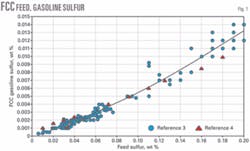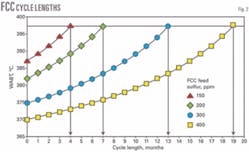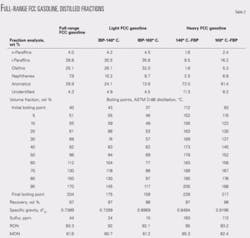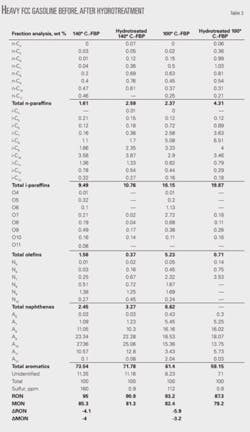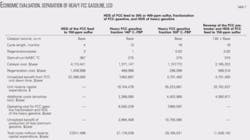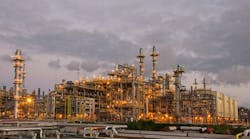This article examines the feasibility of producing near-zero sulfur FCC gasoline by FCC feed pretreatment and gasoline posttreatment. The transition to 10 from 50 ppm sulfur in the FCC gasoline using feed pretreatment drastically shortens the cycle length and significantly increases the cost for production of near-zero sulfur gasoline.
A possible way to cut costs is to fractionate full-range FCC gasoline into two fractions: initial boiling point (IBP) to 140° C. and 140° C. to final boiling point (FBP) and hydrotreat the heavy fraction. Refiners, however, should perform the fractionation by undercutting the FCC gasoline in the main fractionator and then distill the heavy gasoline from the light cycle oil (LCO) in a separate column.
If the fractionation is performed on the full-range FCC gasoline, the operating cost is too high and posttreatment becomes unattractive economically. Revamping the FCC pretreater to increase the catalyst volume offers the best economics regardless of the relatively higher capital expenditure.
FCC sulfur
In accordance with European Union Directive 2003/17/EC, sulfur in automotive gasoline must be lower than 10 ppm starting Jan. 1, 2009. FCC gasoline contains about 90% of the sulfur in the finished gasoline pool. This is why the main technologies to reduce gasoline sulfur content are those that desulfurize FCC gasoline.1
Two methods are used to reduce sulfur in FCC gasolineFCC feed pretreatment and FCC gasoline posttreatment. FCC feed pretreatment technologies due to catalyst developments allow the attainment of ultralow-sulfur levels (50 ppm) in the FCC gasoline without requiring a unit revamp.2
Sulfur less than 10 ppm (near-zero sulfur) is difficult, however, for FCC pretreating units. It is hard to achieve without increasing the catalyst volume; otherwise the cycle length would be unacceptably lower.
Fig. 1 shows the relationship between FCC gasoline sulfur and FCC feed sulfur from two independent sources.3 4 These data show that attaining 10-ppm sulfur in the FCC gasoline requires an FCC feed sulfur level of 100-200 ppm.
On the basis of results from the Lukoil Neftochim Bulgaria (LNB) FCC pretreating unit using a Haldor-Topsoe TK-558 Brim catalyst,5 we estimated the expected cycle length at a liquid hourly space velocity of 1.2 hr-1 and an end-of-run weighted average bed temperature (WABT) of 398° C. (Fig. 2).
Fig. 2 shows that 150-ppm sulfur in the FCC feed is possible for no longer than 4 months and 200 ppm for 7 months. Such short cycle lengths are difficult to justify economically.
A longer cycle length would require a revamp to increase the catalyst volume. For example, the estimated required catalyst volume to achieve an 18-month cycle length is 92% more than the existing volume.
We therefore investigated the feasibility of combining pretreatment and posttreatment technologies to attain sulfur levels in the FCC gasoline of less than 10 ppm with the aim to find an optimum solution.
Experimental
A sample of FCC gasoline from the LNB FCC unit was distilled into four fractions in an apparatus in accordance with ASTM D-86:
- IBP-100° C.
- 100-120° C.
- 120-140° C.
- 140° C.-FBP.
Table 1 shows the content of these fractions in the whole FCC gasoline sample along with the sulfur and olefins content. Another sample of FCC gasoline was fractionated in a TBP Fischer Autodest 800 AC column at atmospheric pressure in accordance with ASTM D-2892. The sample was separated into light and heavy gasoline with different fractionation ranges: IBP-100° C and 100° C.-FBP, and IBP-140° C. and 140° C.-FBP, respectively.
The efficiency of the rectification column packing was equivalent to 15 theoretical plates. The reflux ratio was 5. The yields of heavy gasoline were 30% in the 100° C.-FBP fraction and 15% in the 140° C.-FBP fraction. During the rectification, we recorded losses of 13%, which we considered as part of the light gasoline fraction.
Table 2 shows the physical and chemical properties of the whole FCC gasoline sample and the distilled light and heavy gasoline fractions.
Hydrotreating both heavy FCC gasoline fractions occurred on the Topsoe TK-576 BRIM catalyst in a trickle bed pilot-plant at these conditions:
- Reactor inlet temperature, 280° C.
- Liquid hourly space velocity, 2 hr-1.
- Reactor total pressure, 3.5 MPa
- Hydrogen containing gas-feed ratio, 200 N cu m/cu m
- Hydrogen in treating gas, 99 vol %.
Reference 6 shows the processing procedure.
Results
Full-range FCC gasoline hydrotreatment leads to a significant reduction in octane number.7 8 That is why we distilled the FCC gasoline in different fractionsto know the sulfur and higher olefins distribution.
Table 1 shows that 60% of the sulfur is in the fraction boiling greater than 140° C. and only 2% of total FCC gasoline olefins is in that fraction. Lowering the IBP of the heavy gasoline increases the high-octane olefins content and, therefore, during hydrotreatment, a greater loss of octane is expected. We therefore distilled the FCC gasoline into fractions greater than and less than 140° C. to keep the heavy gasoline’s octane number as high as possible.
To discover the effect of fractionation cut point on octane loss during heavy gasoline hydrotreatment, we also fractionated the full-range FCC gasoline into fractions boiling at greater than and less than 100° C.
Table 3 summarizes the detailed hydrocarbon composition of the heavy FCC gasoline fractions before and after hydrotreatment.
These data indicate that hydrotreatment reduces the sulfur level to less than 1 ppm but also leads to saturation of 80% of olefins and 3% of aromatics. Due to hydrotreatment, the content of paraffins and naphthenes in the hydrotreated heavy gasoline increased compared with the unhydrotreated gasoline.
Hydrotreating also resulted in octane losses of about 4 points (RON and MON) in the 140° C.-FBP fraction and of 5.9 RON and 3.2 MON in the 100° C.-FBP fraction. The octane number of all of the blended FCC unhydrotreated gasoline fractions was about 1 point lower than that of the starting full-range FCC gasoline.
This could be due to losses of about 13% of the light gasoline registered during fractionation of the full-range FCC gasoline in the Fischer Autodest 800 AC column. We therefore evaluated the octane loss of the full FCC gasoline based on the octane of the blended light and heavy unhydrotreated gasoline.
Table 4 shows that fractionating the FCC gasoline in the light and heavy fractions with a cut point of 100° C. and hydrotreating the heavy 100° C.-FBP fraction led to an octane loss in the full-range FCC gasoline of 1.8 RON and 1.0 MON.
Fractionating with a cut point of 140° C. and hydrotreating the heavy 140° C.-FBP fraction led to an octane loss in the full-range FCC gasoline of 0.6 RON and 0.6 MON.
Assuming a sulfur distribution in the FCC gasoline shown in Table 1, in which total FCC gasoline sulfur is 36.8 ppm, then at 20 ppm total FCC gasoline sulfur the light gasoline (IBP-140° C.) sulfur should be 10 ppm. At this sulfur level in the fraction IBP-140° C. and less than 1 ppm in the hydrotreated heavy gasoline, the total FCC gasoline sulfur should be 8.9 ppm (85% IBP-140° C. and 15% 140° C.-FBP). The octane losses in this case would be 0.6 RON and 0.6 MON.
Fig. 1 shows that 20 ppm sulfur in the FCC gasoline corresponds to a FCC feed sulfur level of 400 ppm. Fig. 2 shows that at 400 ppm sulfur in the FCC feed (hydrotreated vacuum gas oil) the expected cycle length of the FCC pretreater is 19 months.
Economic evaluation
For an economical evaluation of possible variants for production of FCC gasoline with sulfur content not higher than 10 ppm, we made these assumptions:
- The FCC pretreater capacity is 235 tons/hr (39,000 b/d).
- The unrealized benefit of 1 day downtime of the FCC unit is about $746,269, based on November 2007 data.
- Catalyst regeneration is performed ex-situ and the FCC pretreating unit downtime for catalyst unloading and reloading, including the time necessary for regeneration is 10 days, based on our field experience.
- Cost for regeneration and activation (sulfiding) of the FCC pretreater catalyst is $470,000, based on 2007 LNB data.
- After each regeneration the catalyst guard bed is replaced, which costs $63,625.
- The maximum number of catalyst regenerations is three.
- The duration of using one catalyst charge in the LNB FCC pretreater is 36 months. This figure is based on the amount of vacuum gas oil (VGO) processed for that period and the metals level in the VGO. We found that VGO from Urals crude (typical LNB crude) had high levels of arsenic (0.29 ppm), which shortens catalyst life.
- The cost for fractionation of the FCC gasoline into light and heavy fractions with a 140° C. cut point is about $19/ton FCC gasoline. The cost to fractionate FCC gasoline into light and heavy fractions with a 100° C. cut point is about $11/ton FCC gasoline. These figures are based on the required heat for FCC gasoline fractionation.
- The cost of heavy FCC gasoline hydrotreating is $8.6/ton FCC gasoline. This is based on field experience with LNB diesel hydrotreaters.
- The capital expenditure of revamping the existing LNB FCC pretreater is about $32.5 million. This is based on data for a future revamp of the existing LNB middle distillate hydrotreaters.
- Capital expenditure for constructing a new hydrotreater for desulfurization of heavy FCC gasoline is $20 million for a capacity of 20 tons/hr and $40 million for a capacity of 40 tons/hr.
- Capital expenditure for constructing a new unit for FCC gasoline fractionation is $3 million.
- Additional costs (amortization) are 12% of capital expenditures.
- The price of regular gasoline is $784/ton and premium gasoline is $806/ton. Production of finished premium gasoline decreases 47% when FCC gasoline is fractionated with a cut point of 100° C. and 13% when the cut point is 140° C.
Table 5 shows estimated costs of the different investigated cases for producing FCC gasoline with sulfur less than 10 ppm. These data indicate that the capital expenditure is the highest for FCC gasoline fractionation with a cut point of 100° C. and hydrogenation of the heavy gasoline. This case also exhibits the poorest economics.
Fractionation and hydrodesulfurization of heavy gasoline is economically unfavorable mainly because of the high operating cost of fractionation. We investigated another case at a lower operating cost. We found that the main fractionator of the LNB FCC unit was able to undercut the FCC gasoline.
Table 6 shows the distillation characteristics of FCC gasoline and LCO from the LNB FCC unit when the FCC gasoline has been undercut. Comparing these data and those in Table 2 shows that the main fractionator can produce light gasoline, and the heavy gasoline remains in the LCO.
In that case, an additional fractionation column is needed to separate heavy gasoline from LCO. Operating costs of this fractionator would be less than that of the whole FCC gasoline fractionation.
Table 7 summarizes the estimated costs of the different cases for production of 10-ppm sulfur FCC gasoline when the heavy gasoline is separated from the LCO. These data show that fractionation of FCC gasoline into a light and heavy fraction with a cut point of 100° C. and hydrotreating the heavy gasoline is possibly the worst case.
Fractionating the FCC gasoline with a cut point of 140° C. and hydrotreating the heavy gasoline is better economically than operating the existing FCC pretreater at a higher severity. That case, however, is more capital intensive because it requires the construction of an additional fractionator and gasoline hydrotreater. The case with a revamp of the existing FCC pretreater is the most favorable variant.
We have not completely evaluated downtime of the FCC unit for revamping the FCC feed pretreating unit assuming that it could be performed during a scheduled turnaround. This case nevertheless looks significantly better than those with FCC gasoline fractionation and hydrotreating of the heavy gasoline.
Even assuming a technology can selectively hydrodesulfurize with no octane loss,7 8 the high operating cost of fractionation, which requires evaporating and condensing about 80% of the full-range FCC gasoline, is the bottleneck for producing near-zero sulfur FCC gasoline.
Moreover, sulfur in the full-range FCC gasoline should be not more than 20 ppm, otherwise even with hydrodesulfurization of the heavy FCC gasoline, the final blend would not achieve the target of 10-ppm sulfur.
Findings
Our evaluation of the required severity increase in the LNB FCC feed pretreater to guarantee production of 10-ppm sulfur FCC gasoline showed an expected cycle length of about 5 months. This shorter cycle length would result in higher costs and lower FCC unit availability.
Fractionating the FCC gasoline and hydrotreating the heavy fraction allows a lower severity in the FCC pretreater and leads to a reasonable cycle length while producing near-zero sulfur gasoline. The fractionation, however, is only attractive if it is carried out by undercutting the gasoline in the FCC main fractionator and heavy gasoline distilled from the LCO.
If the full-range FCC gasoline is fractionated in a separate column, the benefit of longer FCC unit availability cannot offset the high fractionation operating costs. If a revamp of the FCC pretreater is feasible, this variant offers the best economics regardless of the relatively higher capital expenditure.
References
- Ivanov, A., and Argirov, G., “Refining technology achievements to produce environmental friendly gasoline,” Oxidation Communication, Vol. 28 (2005), No. 2, pp. 253-72.
- Stratiev, D., Donov, A., and Stratiev, G., “Evaluation of Lukoil Neftochim Bourgas fluid catalytic cracking feed hydrotreater performance in a mild hydrocracking mode,” Oil & Gas European Magazine, June 2005, pp. 87-91.
- Andonov, G., Petrov, S., Stratiev, D., and Zeuthen, P., “MHC mode vs HDS mode in an FCC unit in relation to Euro IV fuels specifications,” presented to the European Refining Technology Conference 10th Annual Meeting, Nov. 14-16, 2005, Vienna.
- Zeuthen, Per, “FCC Pretreatment CatalystsOptimum Catalyst Selection and Improved Stability,” presented to the Haldor Topsoe Hydrotreating Seminar, Sept. 10-12, 2006, Copenhagen.
- Dobrev, D., Stratiev, D., Petkov, P., Tzingov, T., and Argirov, G., “Fluid catalytic cracking Feed pretreatment a way for production of ultra clean fuels,” proceedings of the 43rd International Petroleum Conference, Bratislava, Sept. 25-26, 2007.
- Stratiev, D., Ivanov, A., and Jelyaskova, M., “Effect of feedstock end boiling point on product sulfur during ultra deep diesel hydrodesulfurization,” Oil & Gas European Magazine, No. 4, 2004, p. 188.
- Simpson, S.G., “European Gasoline Solutions,” proceedings of the 39th International Petroleum Conference, Bratislava, Sept. 20-23, 1999, pp. A9-1-A9-12.
- Rutherford, F.M., and von Schmidt, E., “Processing Strategies for FCC Gasoline to Meet the EU Fuels Specifications,” Grace FCC Technology Conference 1998, Lisbon, Sept. 1-4, 1998.
The authors
Dicho Stratiev ([email protected]) is an associate professor, PhD, and research department manager for Lukoil Neftochim Bourgas, Bulgaria. He has held several positions in research and production activities during his 17 years with Lukoil Neftochim Bourgas. Stratiev holds an MS in chemical engineering in organic chemistry and a PhD in oil refining from Bourgas University.
Todor Tzingov is a research associate in the catalysis section of the Lukoil Neftochim Bourgas research and development department. He joined Lukoil Neftochim Bourgas in 1977 as a shift supervisor in the normal paraffins unit. In 1981, Tzingov was appointed as a research associate in the catalysis laboratory in the Research Institute for Oil Refining and Petrochemistry in Lukoil Neftochim. In 2004 he was appointed too his current position. He holds an MS in chemical engineering in oil refining engineering from Bourgas University.
Georgi Argirov is a research associate in the catalysis section of the Lukoil Neftochim Bourgas research and development department. He joined Lukoil Neftochim Bourgas in 2001 as an operator in the absorption gas fractionating unit. After this, Argirov joined the catalysis laboratory in the Research Institute for Oil Refining and Petrochemistry as a process engineer. He holds an MS in inorganic chemistry engineering from Bourgas University.
Ivelina Shishkova is a research associate in the catalysis section of the Lukoil Neftochim Bourgas research and development department. She joined Lukoil Neftochim Bourgas in 2002 as a process engineer in the catalysis laboratory in the Research Institute for Oil Refining and Petrochemistry. Shishkova was appointed as a research associate in this laboratory in 2003. She holds an MS in organic chemistry engineering from Bourgas University.
